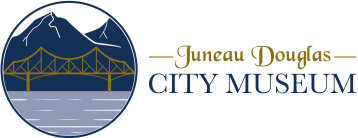Gastineau Channel Memories
Osborne, Thomas E.
Tom and Dorothy Osborne
I was born to George and Bertha Osborne on April 12, 1922, in Cordova. Dr. Council was the doctor that delivered me and I joined my brother Orvald who was 16 months older, and a half sister Lillian that was fifteen years older. My father and his brother had a jewelry store in Cordova. We moved to Juneau in March 1927, when my father went to work for the Nugget Shop, eventually opening a store by himself and did repair work and engraving for other stores. He engraved the scissors that were used to cut the ribbons at the dedication of the Alcan Highway.
I entered kindergarten in the library that was housed in the fire hall on the corner of Fourth and Main. First grade through eight was in the school between 5th and 6th Streets and graduated from Juneau High School next door, on Main between 5th and 6th, now state offices for the legislators.
I spent most of my summers going swimming, fishing and bird hunting. We had a swimming hole in the rock where the Glacier Visitor Center is now, and one spot near the Skaters Cabin and we had a favorite spot at Lemon Creek. Of course, we walked wherever we wanted to go. Charlie Switzer would give us a ride when he was going to town to deliver milk and would always give us a bottle of milk. One summer my brother Orvald, Jack Lund and I rowed up Taku Inlet to Turner Lake and camped for a week, then rowed home. Spent lots of time on Mt. Roberts grouse and ptarmigan hunting, also deer hunting in the fall.
I graduated in 1940, and spent my first summer working on Ladd Field in Fairbanks. That was some trip by boat to Seward and bus to Fairbanks. In December 1941, I was hired by George Baggen to take a barge load of lumber to Sitka with the Sampson II (later his son was to start the Sampson Tug and Barge Co). Near Freshwater Bay, we encountered a bad storm and anchored in Pavlof Harbor to wait it out. After several days in the harbor we were able to proceed. We entered Peril Straits about 1 a.m. in pitch black dark. Imagine our surprise to be stopped by a boat with drawn guns and told we were at war with Japan. We had to anchor and wait for daylight before we could proceed. I worked for a while on the dock for the A J Mine hauling dynamite, sand and whatever they needed. Was moved to the Subport for a short time before going in the service in early 1943.
I took my basic training in Kerns, Utah. I trained in Denver, Colorado, to repair the computers that operated the remote controlled gun turrets on B-29 bombers. I was stationed on the Major General Robert Olds, a floating repair ship - ?The First Aircraft Repair Unit-floating.? We shipped out from Mobile, Alabama, went through the Panama Canal to the Pacific, had to stop in Hawaii for minor repairs and then on to Enewetak and Tinian. We moved to Okinawa and were sent to sea to ride out a fierce typhoon that did a lot of damage on Okinawa near the end of the war. We were a complete repair shop for anything they needed. Our personnel on the ship have reunions every year and my wife and I have attended three, all back east, or I should say east of the Mississippi. Our commander is still alive and attends the reunions, General Joseph T. Kingsley, Jr. retired.
I was discharged in 1946, and returned home and worked for my father repairing clocks and watches, but couldn?t stand to be cooped up indoors all the time. I helped Bud Fields build a couple of boats, then bought a boat and went fishing. In those days, you could fish all year round if you wanted. Jack Lund and I trapped several winters and had some experiences that we still talk about.
My father passed away in December 1954. In 1965, my mother moved to the Pioneers Home in Sitka and I moved on board my fishing boat. In 1968, I married Dorothy A. Renhard who was a checker at Foodland Grocery Store. Dorothy went fishing with me and in 1971, we purchased the Nunatak a 65-foot boat from Glacier Bay National Park. We were the first nongovernment people to own the boat and we put the original name Seal on the title. We rented out our house and moved on board the Seal. That fall we traveled to Seattle to do conversion work so we could use it for fishing. We were not able to get back to fish salmon in 1992, so we went tuna fishing off the northern end of Vancouver Island. Some very interesting times, like being 130 miles off shore and getting caught in a nasty, nasty storm, unable to cook or fix anything to eat for about 14 hours. (Did get a few Ritz crackers and peanut butter put together.) We had a lot of good times on the boat, especially our hunting trips, and our trips to Seattle and back were always eventful. We lived on the boat 12 years and sold the boat in 1995.
In the fall of 1991, we decided to build a house on property I had purchased after the war. We had to fall trees and clear the lot. I fished that year with our grandson Jim Beebe, but that turned out to be my last year to fish. In March of 1992 I had to have surgery and took the rest of the year to recuperate. My wife was working for the Forestry Science Laboratory from February 1982 until she retired in June of 1994. Since then we have traveled mostly in Alaska and just try to keep ahead of things.
